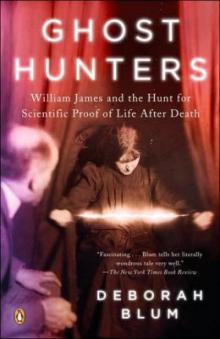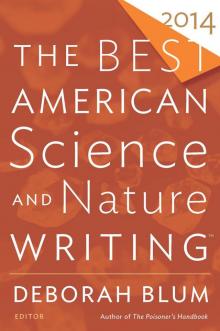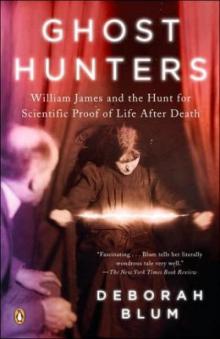- Home
- Deborah Blum
The Best American Science and Nature Writing 2014
The Best American Science and Nature Writing 2014 Read online
Table of Contents
Title Page
Table of Contents
Copyright
Foreword
Introduction
KATHERINE BAGLEY Mixed Up
NICHOLAS CARR The Great Forgetting
DAVID DOBBS The Social Life of Genes
PIPPA GOLDSCHMIDT What Our Telescopes Couldn’t See
AMY HARMON A Race to Save the Orange by Altering Its DNA
ROBIN MARANTZ HENIG A Life-or-Death Situation
VIRGINIA HUGHES 23 and You
FERRIS JABR Why the Brain Prefers Paper
SARAH STEWART JOHNSON O-Rings
BARBARA J. KING When Animals Mourn
BARBARA KINGSOLVER Where It Begins
MAGGIE KOERTH-BAKER Danger! This Mission to Mars Could Bore You to Death!
ELIZABETH KOLBERT The Lost World
JOSHUA LANG Awakening
MARYN McKENNA Imagining the Post-Antibiotics Future
SETH MNOOKIN The Return of Measles
JUSTIN NOBEL Ants Go Marching
FRED PEARCE TV as Birth Control
COREY S. POWELL The Madness of the Planets
ROY SCRANTON Learning How to Die in the Anthropocene
KATE SHEPPARD Under Water
BILL SHERWONIT Twelve Ways of Viewing Alaska’s Wild, White Sheep
REBECCA SOLNIT The Separating Sickness
DAVID TREUER Trapline
E. O. WILSON The Rebirth of Gorongosa
CARL ZIMMER Bringing Them Back to Life
Contributors’ Notes
Other Notable Science and Nature Writing of 2013
Read More from The Best American Series®
About the Editors
Footnotes
Copyright © 2014 by Houghton Mifflin Harcourt Publishing Company
Introduction copyright © 2014 by Deborah Blum
ALL RIGHTS RESERVED
The Best American Science and Nature Writing™ is a trademark of Houghton Mifflin Harcourt Publishing Company. The Best American Series® is a registered trademark of Houghton Mifflin Harcourt Publishing Company.
No part of this work may be reproduced or transmitted in any form or by any means, electronic or mechanical, including photocopying and recording, or by any information storage or retrieval system without the prior written permission of the copyright owner unless such copying is expressly permitted by federal copyright law. With the exception of nonprofit transcription in Braille, Houghton Mifflin Harcourt is not authorized to grant permission for further uses of copyrighted selections reprinted in this book without the permission of their owners. Permission must be obtained from the individual copyright owners identified herein. Address requests for permission to make copies of Houghton Mifflin Harcourt material to Permissions, Houghton Mifflin Harcourt Publishing Company, 215 Park Avenue South, New York, New York 10003.
www.hmhco.com
ISSN 1530-1508
ISBN 978-0-544-00342-2
eISBN 978-0-544-00339-2
v1.0914
“Mixed Up” by Katherine Bagley. First published as “Climate Change Is Causing Some Mixed-Up Wildlife” in Audobon, November 2013. Copyright © 2013 by the National Audubon Society. Reprinted by permission of Audobon magazine.
“The Great Forgetting” by Nicholas Carr. First published in the Atlantic, November 2013. Copyright © 2013 by Nicholas Carr. Reprinted by permission of the author.
“The Social Life of Genes” by David Dobbs. First published in Pacific Standard, September 3, 2013. Copyright © 2013 by David Dobbs. Reprinted by permission of David Dobbs.
“What Our Telescopes Couldn’t See” by Pippa Goldschmidt. First published in the New York Times, September 11, 2013. Copyright © 2014 by Pippa Goldschmidt. Reprinted by permission of Pippa Goldschmidt.
“A Race to Save the Orange by Altering Its DNA” by Amy Harmon. First published in the New York Times, July 27, 2013. Copyright © 2013 the New York Times. All rights reserved. Used by permission and protected by the Copyright Laws of the United States. The printing, copying, redistribution, or retransmission of this Content without express written permission is prohibited.
“A Life-or-Death Situation” by Robin Marantz Henig. First published in the New York Times Magazine, July 21, 2013. Copyright © 2013 by Robin Marantz Henig. Reprinted by permission of Robin Marantz Henig.
“23 and You” by Virginia Hughes. First published in Matter, December 2013. Copyright © 2013 by Virginia Hughes. Reprinted by permission of the author.
“Why the Brain Prefers Paper” by Ferris Jabr. First published in Scientific American,November 2013. Reproduced with permission. Copyright © 2013 Scientific American, a division of Nature America, Inc. All rights reserved.
“O-Rings” by Sarah Stewart Johnson. First published in Harvard Review, Winter 2013. Copyright © 2013 by Sarah Stewart Johnson. Reprinted by permission of Sarah Stewart Johnson.
“When Animals Mourn” by Barbara J. King. First published in Scientific American, July 2013. Reproduced with permission. Copyright © 2013 by Scientific American, a division of Nature America, Inc. All rights reserved.
“Where It Begins” by Barbara Kingsolver. First published in Orion, November/December 2013; commissioned for Knitting Yarns, Ann Hood, ed., W. W. Norton, 2013. Copyright © 2013 by Barbara Kingsolver. Reprinted by permission of Barbara Kingsolver.
“Danger! This Mission to Mars Could Bore You to Death!” by Maggie KoerthBaker. First published in the New York Times Sunday Magazine, July 16, 2013. Copyright © 2014 by Maggie Koerth-Baker and the New York Times. Reprinted by permission of Maggie Koerth-Baker and the New York Times.
“The Lost World” by Elizabeth Kolbert from the book The Sixth Extinction: An Unnatural History by Elizabeth Kolbert. First published in The New Yorker, December 16 and December 23, 2013. Copyright © 2013, 2014 by Elizabeth Kolbert. Permission to reprint granted by Henry Holt and Company, LLC.
“Awakening” by Joshua Lang. First published in the Atlantic, January/February 2013. Copyright © 2013 by the Atlantic Media Co. All rights reserved. Distributed by Tribune Content Agency, LLC.
“Imagining the Post-Antibiotics Future” by Maryn McKenna. First published in Medium, November 20, 2013. Copyright © 2014 by Maryn McKenna. Reprinted by permission of Food & Environment Reporting Network.
“The Return of Measles” by Seth Mnookin. First published in the Boston Globe Magazine, September 29, 2013. Copyright © 2013 by Seth Mnookin. Reprinted by permission of Seth Mnookin.
“Ants Go Marching” by Justin Nobel. First published in Nautilus, July 11, 2013. Copyright © 2013 by Justin Nobel. Reprinted by permission of the author.
“TV as Birth Control” by Fred Pearce. First published in Conservation, September 2013. Copyright © 2014 by Fred Pearce. Reprinted by permission of Fred Pearce.
“The Madness of the Planets” by Corey S. Powell. First published in Nautilus, December 2013. Copyright © 2013 by Corey S. Powell. Reprinted by permission of the author.
“Learning How to Die in the Anthropocene” by Roy Scranton. First published in the New York Times, November 10, 2013. Copyright © 2013 by Roy Scranton. Reprinted by permission of Roy Scranton.
“Under Water” by Kate Sheppard. First published in Mother Jones, July/August 2013. Copyright © 2013 by the Foundation for National Progress. Reprinted by permission.
“Twelve Ways of Viewing Alaska’s Wild, White Sheep” by Bill Sherwonit. First published in Anchorage Press, May 29, 2013. Copyright © 2013 by Bill Sherwonit. Reprinted by permission of Bill Sherwonit.
“The Separating Sickness” by Rebecca Solnit. First published in Harper’s Magazine, June
2013. Copyright © 2014 by Rebecca Solnit. Reprinted by permission of the author.
“Trapline” by David Treuer. First published in Orion, May/June 2013. Copyright © 2013 by David Treuer. Reprinted by permission of the author.
“The Rebirth of Gorongosa” by E. O. Wilson. First published in National Geographic, June 2013. Copyright © 2013 by the National Geographic Society. Reprinted by permission.
“Bringing Them Back to Life” by Carl Zimmer. First published in National Geographic, April 2013. Copyright © 2014 by Carl Zimmer. Reprinted by permission of Carl Zimmer.
Foreword
IN THE SUMMER of 2008, I spent a cool, foggy day hiking in the coastal hills of Wales with Sir John Houghton, one of the world’s leading climate scientists. As we tramped through wet, sheep-nibbled grass, the landscape seemed to dissolve into the heavy mists that closed around us, bounding our horizons. Every now and then, through breaks in the fog, we glimpsed vistas of green, treeless hills sloping toward the Irish Sea. Then the view would fade to gray again, stranding us in a world drained of color.
Over the course of that damp day we talked about another sort of shrinking horizon, one composed of fast-vanishing opportunities to prevent irreversible and catastrophic climate change. At the time of our hike it still seemed possible that the world’s nations might manage to limit greenhouse gas emissions to levels that would not prove utterly disruptive. Most scientists believe the planet’s average global temperature must rise no more than 2 degrees Celsius above preindustrial levels if we are to minimize the hazards a hotter world will bring: melting ice sheets, rising seas, extreme weather, extinctions, crop failures, severe droughts.
Houghton served for nearly fifteen years as one of the lead scientists on the Intergovernmental Panel on Climate Change, overseeing the release of the world’s most authoritative reports on the subject. I asked him how much time we had to turn things around. “We have seven years,” he said. To confine global warming to 2 degrees Celsius, our emissions of greenhouse gases would have to peak in 2015 and decline steadily thereafter.
We’ll surely miss that deadline, and in the meantime we’re setting the worst sorts of records. In May 2013 the amount of carbon dioxide in the atmosphere reached 400 parts per million, a level unmatched since 3 million years ago, when sea levels may have been 60 feet higher than today. That dreary benchmark should have made headlines, trumping every other story. Instead, some of our leading news organizations have cut back on environmental coverage. Why does the most important subject of our time receive such underwhelming attention? I sometimes fantasize that daily reports of carbon dioxide concentrations will displace the latest figures from the Dow Jones or that dancers at a Super Bowl half-time spectacle will enact how sea-level rise will force the Miami Dolphins to seek a new home before the century ends.
The world we knew is literally disappearing. Hurricane Sandy chopped more than 30 feet off New Jersey’s beaches, redrawing the state’s coastline overnight. Such storms will become more frequent and more devastating in the decades ahead. What will it take to wake us up? Perhaps some of the remarkable stories in this collection will help. Few writers have done more than Elizabeth Kolbert to alert us to the enormous scale and peril of the threat we’ve unleashed on ourselves. This volume contains her magnificent two-part article from The New Yorker, “The Lost World,” which should be required reading for politicians in every nation. (One hesitates to call them leaders.) Kolbert shows how we are now witnessing ecological changes in mere years that once took place over geologic time scales.
Call me biased, but I’m convinced that you will find in these pages the most important journalism of our time, the stories that will last. Whether it’s Nicholas Carr’s account of the corrosive effect of technology on our brains in “The Great Forgetting” or Corey S. Powell’s “The Madness of the Planets,” a lively and lyrical narrative of the dangers lurking in our rough-and-tumble solar system, the articles here are the sort that will change the way you look at the world. They also make for delightful and often moving reading. I know I will never forget the planetary scientist Sarah Stewart Johnson’s “O-Rings,” with its unexpected links between Antarctic exploration and . . . well, I won’t spoil it for you. I was astonished to learn from Johnson that “O-Rings” is her first published essay. I’m certain it won’t be her last.
All these stories were chosen by Deborah Blum, one of the best science journalists in the business. I’ve been a fan ever since I first read her Pulitzer Prize–winning series of articles The Monkey Wars more than twenty years ago. I feel privileged to share these pages with her. I try to read widely when searching for articles for this collection, but Blum opened my eyes to a number of wonderful new publications, which I hope will find a wider audience. Now it’s time for all the members of that audience to settle into their favorite chairs or curl up in bed and discover twenty-six stories that matter.
I hope too that readers, writers, and editors will nominate their favorite articles for next year’s anthology at http://timfolger.net/forums. The criteria for submissions and deadlines, and the address to which entries should be sent, can be found in the “news and announcements” forum on my web site. Once again this year I’m offering an incentive to enlist readers to scour the nation in search of good science and nature writing: send me an article that I haven’t found, and if the article makes it into the anthology, I’ll mail you a free copy of next year’s edition. What do you think, Deborah? Can I get you to sign those copies? I also encourage readers to use the forums to leave feedback about the collection and to discuss all things scientific. The best way for publications to guarantee that their articles are considered for inclusion in the anthology is to place me on their subscription list, using the address posted in the “news and announcements” section of the forums.
I’d like to thank Deborah Blum for putting together such a compelling collection this year. If you’d like to keep up with her writing, I encourage you to follow “Poison Pen,” her New York Times blog, and “Elemental,” her blog for Wired magazine. Once again this year I’m indebted to Nina Barnett and her colleagues at Houghton Mifflin Harcourt, who make this collection possible. And I’m most grateful of all for my wise and beauteous khaleesi, Anne Nolan. Where would I be without you?
TIM FOLGER
Introduction
LET’S BEGIN with a summer afternoon in Nevada some twenty-five years ago, hot and quiet, except for the faint, sly rustle of the wind in the desert sand.
Back then I was obsessively following a story about flawed designs of nuclear weapons. In the midst of my pursuit, the military scheduled an underground test of one of the warheads in our stockpile of nuclear armaments. The test was to be conducted at the Nevada Test Site (now called the Nevada National Security Site), a well-guarded stretch of rocky desert northwest of Las Vegas.
I wanted to be there. Somehow the bomb testers didn’t think that was a good idea. But they did agree to a guided tour before the detonation, a chance to walk the underground tunnel that led to ground zero. My photographer and I had to get FBI clearance to go on the tour. The waiting period led me to neurotically wonder whether my teenage antiwar-protesting days would become an issue. I had skipped high school to attend some remarkably peaceful marches at the University of Georgia. Now suddenly I was a conspiracy theorist. “They used to fly airplanes over the protests to take photographs of the protesters, you know,” I told my husband, a former U.S. Army journalist, in a hissing way. He rolled his eyes. And rolled them again when the clearance sailed through.
The tunnel, as I remember, was quiet, a narrow cave of rough, dark rock, lit by the blue glow of fluorescence. Cables and boxy machinery had been strung down its length to the point where the warhead would wait. They’d dug it deep under one of the mountainous outcroppings that line the Nevada desert, and standing there, you could imagine how the place would shake when the detonation occurred. The rock floor beneath your feet would shatter and the mountain would shimmy, dancing on the
desert. But still I was more interested in what lay aboveground, the relics of the far more primitive tests from earlier days.
In the 1950s and early 1960s, the United States tested warheads aboveground. A hundred mushroom clouds blossomed, mostly here in Nevada, before we moved everything underground. Tourists in Las Vegas would gather to watch these demonstrations, applauding as the atomic storm flashed upward, lighting the sky, darkening it. They say the clouds were visible a hundred miles away. We might shake our heads today over such nuclear tourism, but people weren’t so aware back then of the invisible drift of radioactive particles and the dangers they carried. That awareness would come later, along with a rise in radiation-induced illnesses across a swath of Nevada. In the moment, though, there was mostly a celebratory sense of dominance, pride that we could harness this wild blaze of power.
Meanwhile, scientists continued to calculate, study the extent of that power. In conjunction with those showy explosions, experimenters at the test site built houses and banks, bridges and stores, set at varying differences from ground zero so they could measure the range and power of the bomb’s blast furnace.
On the day of our visit, the landscape of the old “bomb towns” was part of the driving tour. Through the car windows we could see the metal supports of a bridge twisted into black tumbleweed, brick houses with doors and windows blown out by the wind. We parked some distance away, not too far from a crater carved in the desert floor by an old impact. The test site is 680 square miles of mostly wild terrain, and it was moonscape quiet as we stepped out of the car.
“What’s that yellow tape for?” I asked, pointing to some rough rectangles blocked off by what looked like crime-scene tape.
“Those are radioactive hot spots,” our guide answered.
Only a few minutes later the wind came up in a faint howl, dust wrapped around us like a ground fog, and through this brown-gray mist the guide’s voice reassured us: “Don’t worry. We’ll check you out for radiation levels before you leave.”

 Love at Goon Park: Harry Harlow and the Science of Affection
Love at Goon Park: Harry Harlow and the Science of Affection The Poison Squad
The Poison Squad Ghost Hunters: The Victorians and the Hunt for Proof of Life After Death
Ghost Hunters: The Victorians and the Hunt for Proof of Life After Death The Poisoner's Handbook
The Poisoner's Handbook Angel Killer
Angel Killer The Best American Science and Nature Writing 2014
The Best American Science and Nature Writing 2014 The Ghost Hunters
The Ghost Hunters Love at Goon Park
Love at Goon Park